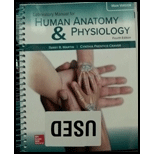
Laboratory Manual For Human Anatomy & Physiology
4th Edition
ISBN: 9781260159080
Author: Martin, Terry R., Prentice-craver, Cynthia
Publisher: Mcgraw-hill Education,
expand_more
expand_more
format_list_bulleted
Concept explainers
Textbook Question
Chapter 18, Problem 7PL
Pre-Lab Questions Select the correct answer for each of the following questions:
The upper and lower limb bones develop from intramembranous ossification.
- True _________
- False ___________
Expert Solution & Answer
Trending nowThis is a popular solution!

Students have asked these similar questions
The humerus, radius, and _______________________ articulate to form the elbow joint.
The number of separate bones in the vertebral column of an adult is _______________________.
The pedicles, laminae, and _______________________ of a vertebra form the vertebral arch.
Chapter 18 Solutions
Laboratory Manual For Human Anatomy & Physiology
Ch. 18 - Prob. 1PLCh. 18 - Pre-Lab Questions Select the correct answer for...Ch. 18 - Pre-Lab Questions Select the correct answer for...Ch. 18 - Pre-Lab Questions Select the correct answer for...Ch. 18 - Pre-Lab Questions Select the correct answer for...Ch. 18 - Pre-Lab Questions Select the correct answer for...Ch. 18 - Pre-Lab Questions Select the correct answer for...Ch. 18 - Pre-Lab Questions Select the correct answer for...Ch. 18 - Complete the following: List all of the bones that...Ch. 18 - Complete the following: List all of the bones that...
Ch. 18 - Complete the following: List all of the bones that...Ch. 18 - Complete the following: List all of the bones that...Ch. 18 - Complete the following: Describe the function of...Ch. 18 - Complete the following: That is the final outcome...Ch. 18 - Why can it be difficult to match the...Ch. 18 - Locate and describe the discernible ossification...Ch. 18 - FIGURE 18.8 Label the fetal bones and fontanels by...
Additional Science Textbook Solutions
Find more solutions based on key concepts
Some people compare DNA to a blueprint stored in the office of a construction company. Explain how this analogy...
Biology: Concepts and Investigations
Consider the experiment described in Section 2.1 in which Ted Garland and colleagues bred mice to run long dist...
Evolutionary Analysis (5th Edition)
Why is it unlikely that two neighboring water molecules would be arranged like this?
Campbell Biology (11th Edition)
Why is it necessary to be in a pressurized cabin when flying at 30,000 feet?
Anatomy & Physiology
More than one choice may apply. Using the terms listed below, fill in the blank with the proper term. anterior ...
Essentials of Human Anatomy & Physiology (11th Edition)
Knowledge Booster
Learn more about
Need a deep-dive on the concept behind this application? Look no further. Learn more about this topic, biology and related others by exploring similar questions and additional content below.Similar questions
- The parietal bones are firmly interlocked along the midline by the _______________________ suture.arrow_forwardIdentify each wrist bone. Each letter will only be used once. Scaphoid Trapezoid Triquetrum Trapezium Pisiform____ Capitate Hamate_____ Lunate ________________________________________________________________________________ Identify each ankle bone. Each letter will only be used once. Talus____ Lateral cuneiform Calcaneus_____ Navicular Cuboid Medial cuneiform Intermediate cuneiformarrow_forwardThe temporal bones are joined to the parietal bones along the _______________________ sutures.arrow_forward
- Identify the bones and markings of the leg. Each letter will only be used once. Lateral condyle Greater trochanter Fibula_____ Medial malleolus Lesser trochanter Medial epicondyle Lateral epicondyle Patella Tibia Intercondylar eminence Femur Intercondylar fossa_____ Medial condyle Tibial tuberosity Lateral malleolus _______________________________________________________________________ Name the 3 groups of bones that form the hand: Name the 3 groups of bones that form the foot:arrow_forwardanswer in correct order and please answer quicklyarrow_forwardPlease answer only name . Identify the bones and markings of the pectoral girdle. Each letter will only be used once. Vertebral border Clavicle Glenoid cavity Scapular spine Superior angle Scapula Axillary border Coracoid process Acromion Inferior angle.arrow_forward
- Answer please don't copy from Googlearrow_forwardPlease answer the following question regarding the provided image: PART A What bone is this? What pathology is indicated on this bone? Describe one trait you used to make this pathology identification. Is this pathology antemortem or perimortem? PART B What bone is this? What pathology is indicated on this bone? Describe one trait you used to make this pathology identification. Is this pathology antemortem or perimortem?arrow_forwardThe tip of the shoulder is the _______________________ of the scapula.arrow_forward
- Read the following questions carefully and please respond explaining and answering all the questions, please post ref from any on line resourcem answer the questions. Q1:Describe bone physiology and the bone remodeling cycle. Be sure to emphasize the two types of bone tissue and the roles of osteoblasts and 02: Explain the relationship between calcium and bones. Why is Vitamin D important for bone health? Q3: Explain how the body controls calcium levels in the bones and blood. Be sure to describe the roles of parathyroid hormone (PTH) and calcit Q4: Explain specifically how osteoporosis affects the bone matrix and the normal bone remodeling cycle. Q5: Describe the types of exercise that help prevent osteoporosis. Why?arrow_forwardAHS 131 - Skeletal System - Bone Composition, Structures, Bone Names and their parts. These are the structures and names that you will need to know for your AHS 131 Bone Lab Exam. Please review and rewrite the names in the space below. When appropriate include the function of the structure. Axial Skeleton Skull Facial Bones Мaxillae Anterior Nasal Spine Alveolar Processes Infraorbital Foramen Hard Palate Maxillary Sinus Palantine Nasal Inferior Nasal Conchae Zygomatic Temporal Process Lacrimal Vomer Mandible Body Ramus Angle Condylar Process Head - TMJ (Temporomandibular Joint) Coronoid Process Alveolar Processes Mental Protuberance Mental Foramen Mandibular Foramenarrow_forwardAre those the correct answers?arrow_forward
arrow_back_ios
SEE MORE QUESTIONS
arrow_forward_ios
Recommended textbooks for you
 Medical Terminology for Health Professions, Spira...Health & NutritionISBN:9781305634350Author:Ann Ehrlich, Carol L. Schroeder, Laura Ehrlich, Katrina A. SchroederPublisher:Cengage Learning
Medical Terminology for Health Professions, Spira...Health & NutritionISBN:9781305634350Author:Ann Ehrlich, Carol L. Schroeder, Laura Ehrlich, Katrina A. SchroederPublisher:Cengage Learning




Medical Terminology for Health Professions, Spira...
Health & Nutrition
ISBN:9781305634350
Author:Ann Ehrlich, Carol L. Schroeder, Laura Ehrlich, Katrina A. Schroeder
Publisher:Cengage Learning
How stress affects your body - Sharon Horesh Bergquist; Author: TED-Ed;https://www.youtube.com/watch?v=v-t1Z5-oPtU;License: Standard Youtube License